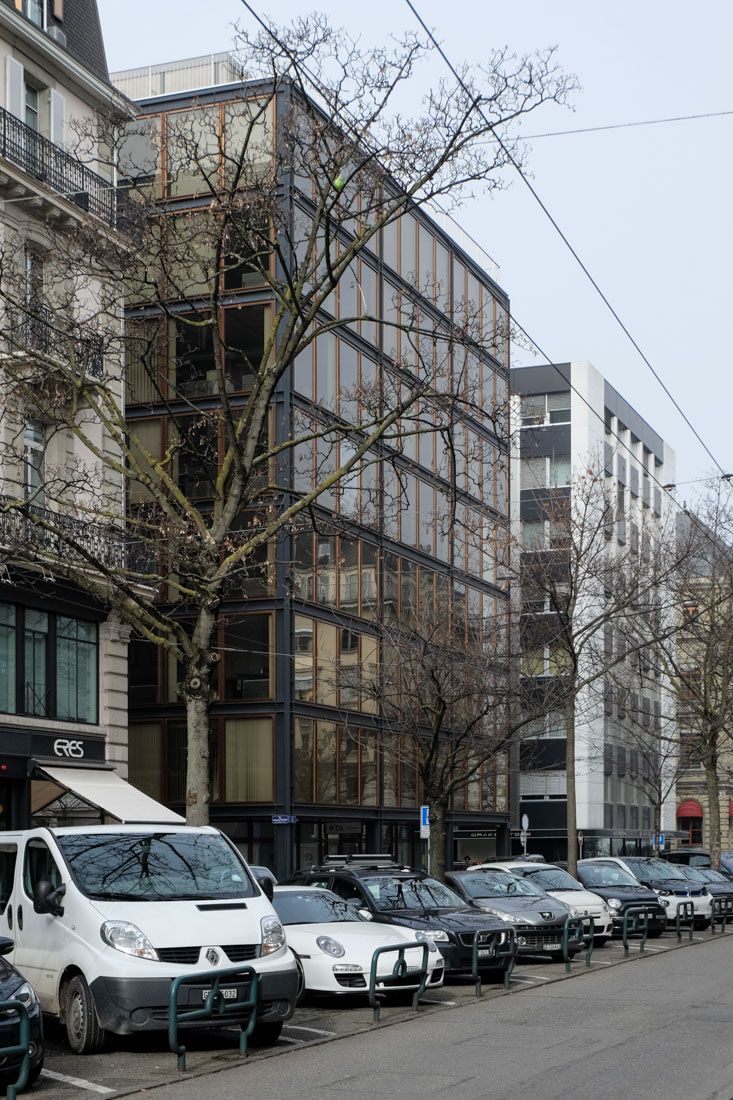 |
 |
 |
 |


Immeuble Administratif
Rue d'Italie 6, Geneva
1965 - 1967
From
1965 to 1967, the Geneva architect François
Maurice was able to build the office building on Rue
d'Italie. In its rationalistic and minimalist appearance,
the building is reminiscent of the architecture of Ludwig
Mies van der Rohe. The building occupies a trapezoidal
plot. A rectangular structure refers to the Rue d'Italie.
A triangular transition piece is created to the adjacent
building. On the one hand, this only appears as a set back
joint, on the other as a recessed structure.
One of the main difficulties of the project was to reconcile the legal framework of the Geneva building code with the customer's requirements. With a maximum building height of 24 meters, it was necessary to accommodate a ground floor with a height of 3.0 m and seven standard floors with a height of 2.60 m. The decision for a steel structure was an obvious one, especially since air conditioning was required for all rooms. The inside of the building is practically free of supporting elements and convinces with an extraordinary flexibility in the division of spaces. The support system consists of steel profiles. These were previously drilled at all possible locations to ensure the installation of the technical systems. Based on a module of 1.84 m, the span of the beams is 7.36 m. The building is braced via the central core with stairs, elevators and ducts. The inner partitions consist of aluminum profiles. The construction is expressed in the tectonically structured facade. The main facade is divided into three fields, each with four axes. The side facades, on the other hand, are divided into two, with each field also having four axes. The ground floor is set back by one module compared to the following floors. This means that the load-bearing supports on the ground floor are free-standing and passers-by are offered protection from the weather. The overarching structure is of a dark color. The large glass plates are surrounded by bronze-colored steel frames.
One of the main difficulties of the project was to reconcile the legal framework of the Geneva building code with the customer's requirements. With a maximum building height of 24 meters, it was necessary to accommodate a ground floor with a height of 3.0 m and seven standard floors with a height of 2.60 m. The decision for a steel structure was an obvious one, especially since air conditioning was required for all rooms. The inside of the building is practically free of supporting elements and convinces with an extraordinary flexibility in the division of spaces. The support system consists of steel profiles. These were previously drilled at all possible locations to ensure the installation of the technical systems. Based on a module of 1.84 m, the span of the beams is 7.36 m. The building is braced via the central core with stairs, elevators and ducts. The inner partitions consist of aluminum profiles. The construction is expressed in the tectonically structured facade. The main facade is divided into three fields, each with four axes. The side facades, on the other hand, are divided into two, with each field also having four axes. The ground floor is set back by one module compared to the following floors. This means that the load-bearing supports on the ground floor are free-standing and passers-by are offered protection from the weather. The overarching structure is of a dark color. The large glass plates are surrounded by bronze-colored steel frames.
In
den Jahren 1965 bis 1967 konnte der Genfer Architekt
François Maurice das Bürogebäude in der Rue d'Italie
realisieren. In seiner rationalistischen und
minimalistischen Erscheinung erinnert das Gebäude an die
Architektur von Ludwig Mies van der Rohe. Das Gebäude
befindet sich auf einem trapezförmigen Grundstück. Ein
reckteckiger Baukörper bezieht sich auf die Rue d'Italie.
Zum angrenzenden Gebäude entsteht ein dreieckiges
Übergangsstück. Dieses erscheint auf der einen Seite
lediglich als zurück versetzte Fuge, auf der anderen als
abgesetzter Baukörper.
Eine der Hauptschwierigkeiten des Projektes lag darin, die
gesetzlichen Rahmenbedingungen mit den Anforderungen des
Kunden zu versöhnen. Bei einer maximalen Gebäudehöhe von
24 Metern galt es ein Erdgeschoss mit 3.0 m Höhe und
sieben Regelgeschosse mit 2.60m Höhe im Volumen
unterzubringen. Der Entscheid für eine Stahlkonstruktion
war naheliegend, zumal für alle Räumlichkeiten eine
Klimatisierung gefordert war. Im Inneren ist das Gebäude
praktisch stützenlos, und überzeugt durch eine
ausserordentliche Flexibilität bei der Raueinteilung. Das
Tragsystem besteht aus Stahlprofilen. Diese wurden
vorgängig an allen möglichen Stellen mit Bohrungen
versehen, um die Leitungsführung der technischen Anlagen
sicherzustellen. Basierend auf einem Modul von 1.84 m
betragen die Spannweiten der Träger 7.36 m. Die
Aussteifung des Gebäudes erfolgt über den zentralen Kern
mit Treppe, Aufzügen und Leitungsschächten. Die inneren
Trennwände bestehen aus Aluminiumprofilen. In der
tektonisch gegliederten Fassade kommt die Konstruktion zum
Ausdruck. Die Hauptfassade wird in drei Felder mit je vier
Achsen unterteilt. Die Seitenfassaden ist hingegen
zweigeteilt, wobei auch hier jedes Feld vier Achsen
aufweist. Das Erdgeschoss ist gegenüber den folgenden
Stockwerken um ein Modul zurückversetzt. Dadurch sind die
tragenden Stützen im Erdgeschoss freistehend, und den
Passanten wird Schutz vor der Witterung geboten. Die
übergeordnete Struktur ist zurückhaltend in dunkler Farbe
gehalten. Die grossen Glasplatten werden von
bronzefarbenen Stahlrahmen gefasst.